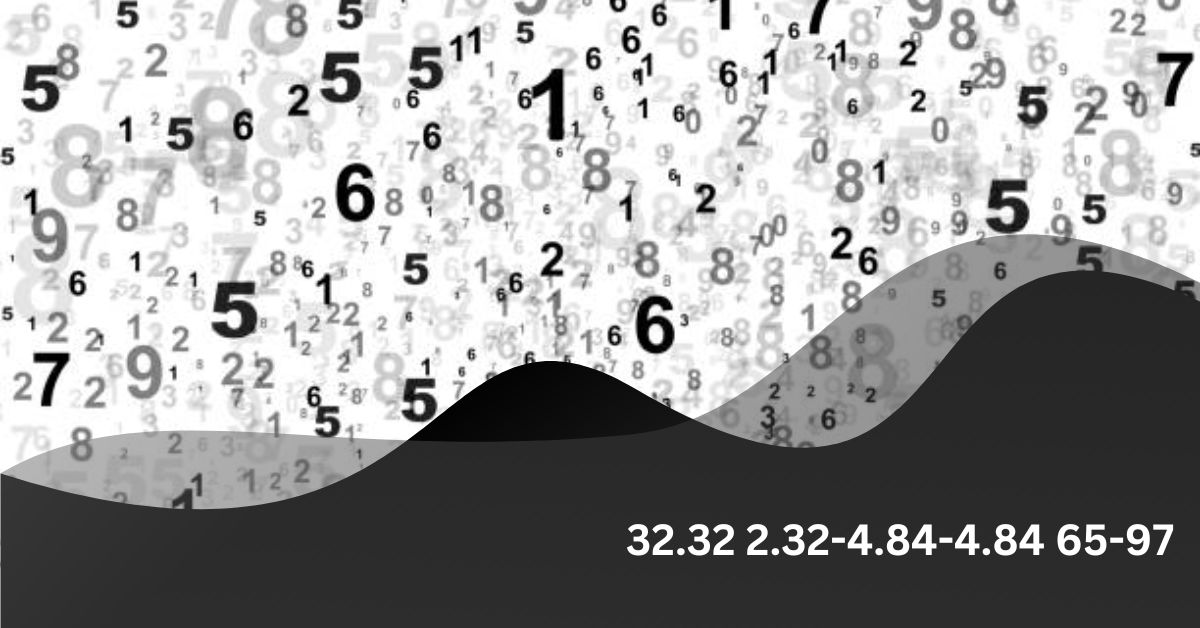The phrase “32.32 2.32-4.84-4.84 65-97” may appear cryptic at first glance, but it can refer to various applications and interpretations across different fields, from mathematics and statistics to engineering and even art.
In this article, we will decode its meaning, explore its implications in various domains, and offer insights that will help you understand this sequence better. We will also analyze its relevance in the current context, especially for audiences in the USA.
Breaking Down the Components
Understanding Numerical Sequences
At its core, “32.32 2.32-4.84-4.84 65-97” can be seen as a series of numerical values. Each component can hold specific significance depending on the context. Let’s break this down into its individual parts:
- 32.32: This could represent a decimal value often found in statistical data, measurement systems, or financial calculations.
- 2.32-4.84-4.84: This sequence might imply a range or an interval. The use of dashes indicates a span, which could be critical in various analytical contexts, including data analysis, measurement, or engineering specifications.
- 65-97: Similar to the previous sequence, this could signify another range or set of values, possibly representing age groups, statistical data points, or anything that fits into a range format.
Potential Interpretations
In Mathematics
Mathematical expressions often utilize sequences and ranges. For example, the sequence “32.32” could represent a particular point in a statistical model, while “2.32-4.84-4.84” might be used to convey a range of values in a data set. The “65-97” could refer to age categories in demographic studies.
In Statistics
In statistics, the interpretation of numerical sequences is crucial for data analysis. The component “32.32” might represent a mean or average value, while the other parts indicate variability or standard deviation. For instance, if these numbers were drawn from a data set measuring income levels in a specific region, they could help illustrate income distribution or economic trends.
In Engineering
In the field of engineering, precise measurements are essential. “32.32” could be a dimension or specification in design, while the other sequences might denote tolerances or allowances in manufacturing processes. Understanding these ranges can be critical for ensuring the safety and reliability of engineered products.
In Art and Design
Artistic interpretation can take on a different lens. The sequence might represent color codes, dimensions of artworks, or even aspects of design specifications. In a more abstract sense, these numbers could inspire patterns or themes in artistic creations.
Analyzing the Context of “32.32 2.32-4.84-4.84 65-97”
Understanding the context is crucial for making sense of “32.32 2.32-4.84-4.84 65-97.” Let’s explore some potential contexts in which this sequence might arise.
Economic Context
In economics, statistical data is often represented in sequences that reflect various metrics. “32.32” could symbolize a GDP growth rate, while the ranges “2.32-4.84-4.84” might indicate inflation rates over a certain period. The “65-97” could represent a demographic trend in employment or economic participation.
Environmental Context
Environmental data often relies on precise measurements and sequences. Here, “32.32” might represent temperature readings in climate studies, while the ranges could reflect variations over time or in different geographical areas.
Health Context
In health and medicine, understanding numerical sequences is vital for analyzing data trends. For example, “32.32” could relate to a critical measurement in a clinical study, while the other sequences could represent ranges in patient health metrics.
Implications and Insights
The Importance of Precision
The sequence “32.32 2.32-4.84-4.84 65-97” emphasizes the importance of precision in data analysis, engineering, and scientific research. Understanding how to interpret these numbers is vital for making informed decisions based on data.
Trends and Predictions
By analyzing data points and sequences like “32.32 2.32-4.84-4.84 65-97,” researchers and professionals can identify trends and make predictions. This can be particularly beneficial in fields such as marketing, health care, and economics.
Enhancing Communication
In various industries, effectively communicating numerical data is essential. The clarity provided by sequences like “32.32 2.32-4.84-4.84 65-97” allows for more effective discussions among professionals and stakeholders.
Frequently Asked Questions (FAQs)
What does “32.32 2.32-4.84-4.84 65-97” represent?
This sequence can represent various numerical values and ranges, commonly found in fields such as mathematics, statistics, engineering, and art. Its exact meaning can depend on the specific context in which it is used.
How can I apply this sequence in my field of work?
Understanding how to interpret and use numerical sequences can enhance data analysis, decision-making, and communication in various fields. It can be particularly beneficial in research, engineering specifications, and economic analyses.
Is “32.32 2.32-4.84-4.84 65-97” significant in statistical analysis?
Yes, sequences like this are significant in statistical analysis as they can indicate mean values, ranges, or variability within a data set. Understanding these metrics can lead to more informed conclusions and predictions.
Can this sequence have artistic significance?
Absolutely! In art and design, numerical sequences can inspire patterns, themes, or dimensions in creative works. Artists often use mathematical concepts to inform their designs and compositions.
Conclusion
In conclusion, “32.32 2.32-4.84-4.84 65-97” is more than just a series of numbers; it represents a complex interplay of data, trends, and insights across various fields.
By understanding its components and the context in which it exists, we can better appreciate its significance and potential applications. Whether you’re working in mathematics, engineering, or art, the ability to interpret numerical sequences is a valuable skill that can enhance your work and decision-making processes.



